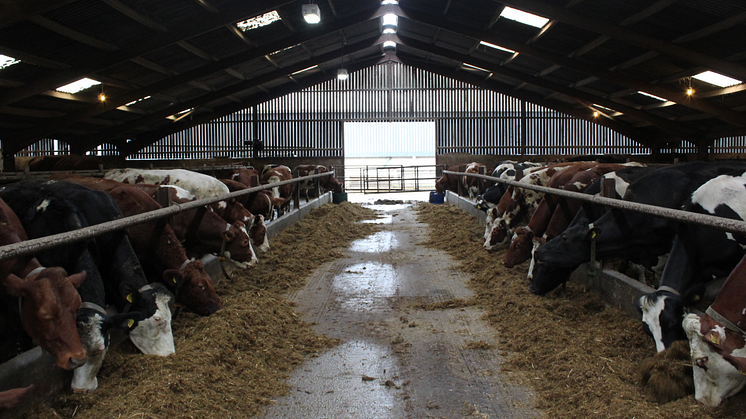
News -
Easy care cows suit high performance system
British Dairying, April 2019 -- The establishment of a crossbred dairy herd while maintaining cow yields has been the target of a Lancashire based milk producer.
The herd is housed all year with all milking cows fed the same complete ration. What started as curiosity and a little bit of intrigue in Scandinavian genetics 20 years ago has led one Lancashire-based producer to pursue a purely cross-bred herd of cows.
Edward and Rebecca Towers, from Hornby near Lancaster, now have 400 milkers and more than 650 young stock, heifers and beef cattle. They’ve been able to expand the herd, which is run using an all-year-round housed and TMR-fed system, thanks to the development of their three-way cross easy-care Norwegian Red, Holstein and Fleckvieh cows.
This is a particularly uniform herd of cows—Edward and his four staff struggle to identify a dominance of any one of the three breeds in the cross-bred mix. The herd has an average somatic cell count of 150,000 cells/ml and a calving interval of 370 days. Yields, on twice-a-day milking, is a respectable 9,605kg of milk per cow per year.
Evolving the herd
Today's herd, which run on 265 hectares of grassland at Holme Head Farm, has evolved from a 300-cow Holstein herd that the Towers started in 1976. Yields for this herd averaged 9,000kg at 3.9% fat and 3.25% protein.
With no real complaints about his Holstein cows, except that he could see they had quite a high price tag attached to their running costs, Edward was intrigued by some Swedish Red cows he saw on farm in Cumbria.
"I could see that they were performing well in a typical Holstein management system," he says. "I was looking to expand the herd and I went on a trip to Sweden. I liked what I saw and bought 100 in-calf Swedish Red heifers during the next four years."
Keen to base the herd's development on sound facts, they set up a separate herd, managed on the same system, and recorded their performance separately through NMR. “Within the first two years we saw better fertility, fewer udder health and foot problems, and yields were only just below those of the Holsteins.
“Looking back, it may have seemed like a bit of a hassle to keep two sets of records. But it was vital in helping us to take the next step and crossing breeds so we could run just one herd,” says Edward.
And it turned out to be a good step forward. “Once we got the crossbreds milking, we liked these better. Then there was no turning back for us.”
Working at the time with Geno—now Genus ABS HYVIG—Edward progressed to the Norwegian Red breed and more recently he's moved from the Montbelliarde to the Fleckvieh as his third cross. He finds this breed has better legs and feet and the combination is providing an ideal cow for his system.
"We don't have a choice here on our system," explains Edward. "The farm is 30 metres above sea level and on silt that drops down to the River Lune. Drought is never a problem but the ground floods easily and at any time of the year.
Farm grassland policy
So grazing cattle here is tricky. We can grow good grass, but it is far more efficient for us to make silage and bring the feed to the cows."
Four cuts of silage are taken and about 20% of the grass is re-seeded annually to maintain maximum productivity. This forms the basis of a complete diet, fed as one ration to all milking cows. It includes bought in straights such as soda wheat, Spey syrup, Trafford Gold, fat, yeast, vitamins and minerals.
Rations are adjusted regularly, but cows are fed maintenance plus around 28 litres. Average yield is currently 30 litres a cow a day.
Bull and breed choices
Edward has been able to cash in on the benefits of each breed in his cross breeding programme. "I don't make the breeding complicated," he stresses.
Genus ABS HYVIG manager Liam Healy encourages producers like Edward to get the best from their cross breeding programme.
"Improvements can be gained by using different breeds—the number and choice of breeds in the programme will be specific to the farm and will vary from unit to unit," he says. "We work closely with producers to develop a breeding plan to suit their goals."
He points out that, when producers are looking to improve traits, they will gain greater improvement from the variation between breeds than within any one breed. "This helps to speed up progress," he notes. "And we will always encourage using the sire within a breed that best meets the breeding criteria for traits.”
When it comes to the Norwegian Red, Edward says that health and fertility are givens in this breed, so he looks for sires with good milk and milk quality. Holstein sires are selected for yield and they must be positive for fat and protein and have good health traits, particularly legs and feet.
Lower vet and medicine costs and the associated milk loss andl abour input are major benefits of Edward’s cross-bred herd. “I know that we use a fraction of tubes for mastitis, and we have only a few cases.”
Individual milk samples for all cows are screened quarterly for Johne’s through Herdwise and infected cows are clearly identified with calves taken off affected dams at birth to prevent spreading the disease. These cows—down to just eight now—are bred to beef bulls. Cattle are also vaccinated for BVD, IBR and Lepto.
“I also use the BVD tag and test to pick up any affected cattle soon after birth. During the past three months we’ve screened 100 calves and they’ve all come back negative. But we know testing for BVD will become compulsory and I’m keen to be ahead here.”
Fertility is carefully managed with collars on heifers and pedometers on cows. “The target is to calve heifers at two years old and breed a calf a year. We’re achieving this, which is why we’re bursting at the seams with youngstock. We may be in a position to sell some heifers or young cows this year, which will be a first.”
Cows are bred six weeks after calving if they are in heat and their vet, Janet Horsfield from Lanes at Garstang, scans cows twice a month. “We only treat one or two a month for non cycling and we’re achieving conception to first service of 48% and a calving interval of 366 days. Two thirds of heifers hold to first service.”
Milk from the herd is sold to local cheesemaker Dewlay, and Edward has seen the all-important quality constituents improve to the current 4.18% fat and 3.43% protein.

Drought at Holme Head Farm is never a problem—the land is liable to flooding at any time of the year. Photo: British Dairying.
Sustainable business
As the crossbreeding effect has moved through the Towers' herd there has been a marked improvement in health and fertility traits while still improving annual production.
"I think we now have a more sustainable herd and business," he concludes. "Cows are not pushed too hard and there are fewer problems that slow things down for staff. It means that the team can manage the day-to-day workload without unreasonable pressure."


